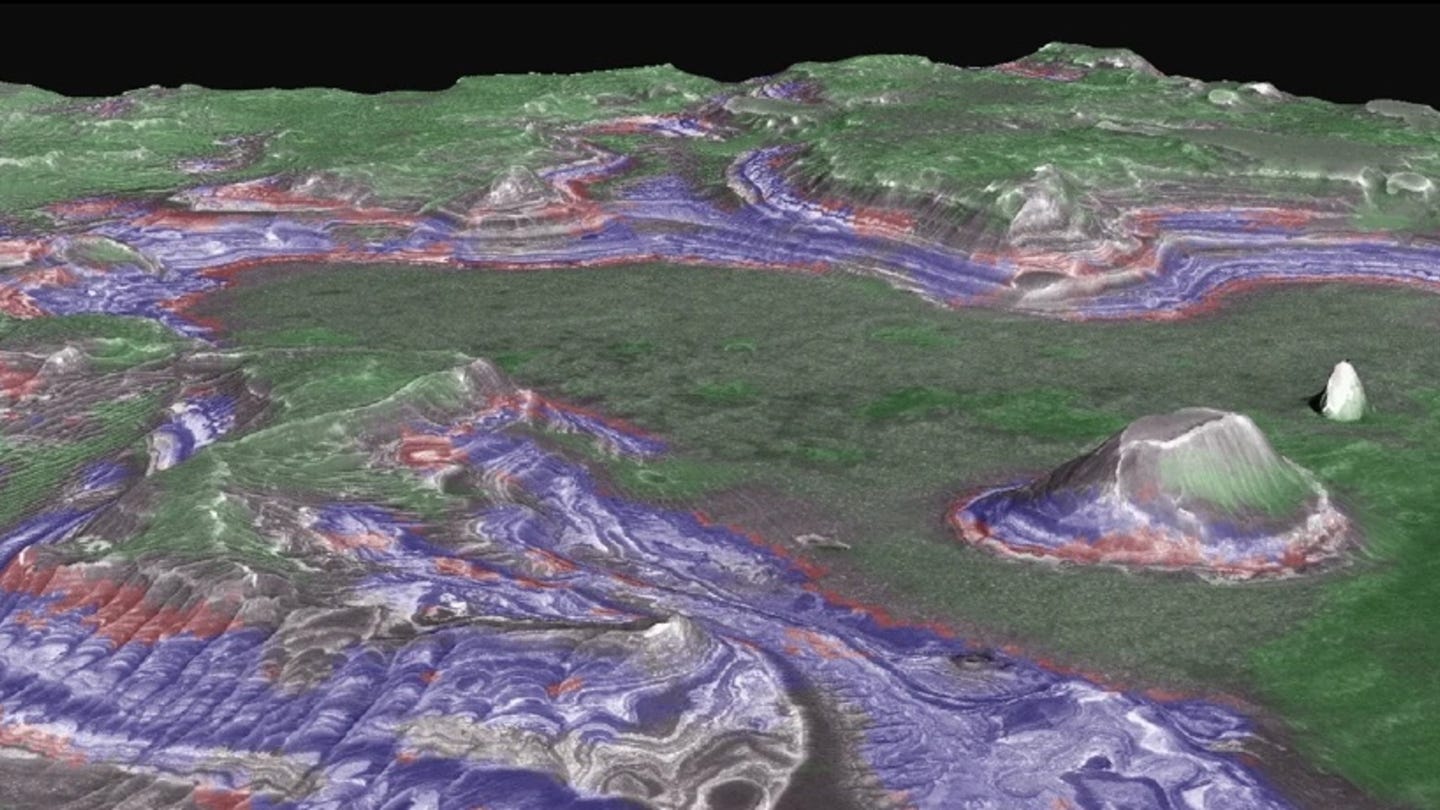Strange new mineral found on Mars points to past potential for life
Scientists discovered ferric hydroxysulfate on Mars, reshaping ideas about the planet’s volcanic and geothermal history

View of the plateau above Juventae Chasma showing the ferric hydroxysulfate in red. (CREDIT: Mario Parente, UMass)
For years, scientists staring at Mars through the eyes of orbiting spacecraft noticed something strange: a mysterious signal in the light spectrum that didn’t match any known mineral. That puzzling fingerprint has now been traced to a new mineral, ferric hydroxysulfate, a discovery that changes how researchers view the Red Planet’s past and its hidden energy.
Chasing a Signal No One Could Place
The story began more than a decade ago when instruments detected an unusual light absorption band at 2.236 micrometers. The Compact Reconnaissance Imaging Spectrometer for Mars, or CRISM, spotted it in places like Aram Chaos, a heavily eroded crater, and on the Juventae Plateau above a deep canyon. But none of the usual suspects—jarosite, gypsum, or clays—fit the bill.
“It just didn’t look like anything we’d cataloged before,” said Janice Bishop, a senior research scientist at the SETI Institute and NASA Ames Research Center.
The challenge was untangling the raw data. Light travels from the Sun, bounces off Mars’ surface, and then filters through the thin atmosphere twice before reaching CRISM. Molecules scatter and gases such as carbon dioxide distort the signal. “The data that comes out of the spectrometer is not usable the way it is,” explained Mario Parente, an associate professor of engineering at the University of Massachusetts Amherst. His team applied deep learning algorithms to correct for those distortions and map the odd signature more clearly.
Building Mars in the Lab
Once researchers had a sharper picture, they turned to the lab. By heating hydrated ferrous sulfate minerals—like rozenite and szomolnokite—under controlled conditions, they produced a mineral that perfectly matched the strange Martian signal.
The key was oxygen. In experiments, samples exposed to air converted into ferric hydroxysulfate, while those sealed in nitrogen did not. The transformation was striking: after just six days at 100 degrees Celsius, rozenite converted into more than 80 percent ferric hydroxysulfate.
“The material formed in these lab experiments is likely a new mineral due to its unique crystal structure and thermal stability,” Bishop said. Official recognition as a new mineral, however, requires finding it on Earth as well.
Where the Mineral Lives on Mars
With the mystery cracked, researchers mapped where the mineral appears on the planet. On the Juventae Plateau, ferric hydroxysulfate shows up as thin layers sandwiched between older basalt flows and hydrated sulfates. The likely trigger was heat from nearby volcanic ash or lava, which baked the sulfates and transformed them.
At Aram Chaos, the mineral appears deeper, near the base of sulfate-rich layers. There, geothermal heat from below may have driven the reaction. The close ties between ferric hydroxysulfate and other hydrated sulfates suggest Mars’ crust was more chemically active than once thought.
What It Reveals About Mars’ History
The presence of ferric hydroxysulfate adds new detail to Mars’ story. For years, sulfates on the planet were explained as products of cold, evaporating water. But this discovery points to another path: heating events tied to volcanism or underground geothermal energy.
“Temperature, pressure and conditions such as pH are all very important indications of what the paleoclimate was,” said Parente. “The presence of this mineral puts a lot more nuance on what was going on.”
Researchers believe the transformations likely happened less than 3 billion years ago during the Amazonian period, suggesting Mars stayed chemically and thermally active far more recently than once thought.
Practical Implications of the Research
Identifying ferric hydroxysulfate gives scientists a better picture of how heat and water shaped Mars’ surface. It means that Mars’ environment wasn’t always static or frozen but continued to shift long after the planet lost most of its atmosphere. That raises fresh questions about whether pockets of heat and water once created conditions friendly to life.
For future missions, this mineral serves as a marker for areas where volcanic or geothermal energy interacted with water. Such sites could be prime locations to search for preserved organic molecules or other signs of habitability. As sample return missions move forward, ferric hydroxysulfate may guide where scientists choose to dig.
The discovery also sharpens the tools researchers use on Earth, improving how mineral signatures are read in noisy planetary data.
Research findings are available online in the journal Nature Communications.
Related Stories
- NASA rover discovery suggests Mars once hosted microbial life
- Mars glaciers found to be 80% ice - could fuel future human settlements
- New study finds life could survive under the surface of Mars and other planets
Like these kind of feel good stories? Get The Brighter Side of News' newsletter.
Joseph Shavit
Science News Writer, Editor-At-Large and Publisher
Joseph Shavit, based in Los Angeles, is a seasoned science journalist, editor and co-founder of The Brighter Side of News, where he transforms complex discoveries into clear, engaging stories for general readers. With experience at major media groups like Times Mirror and Tribune, he writes with both authority and curiosity. His work spans astronomy, physics, quantum mechanics, climate change, artificial intelligence, health, and medicine. Known for linking breakthroughs to real-world markets, he highlights how research transitions into products and industries that shape daily life.



